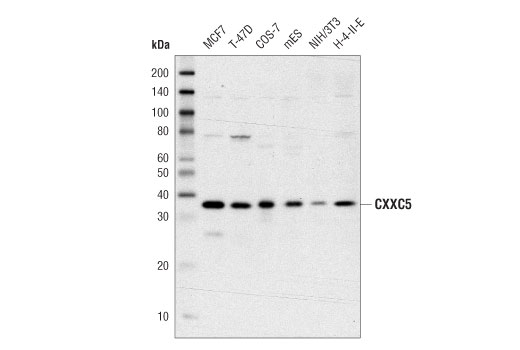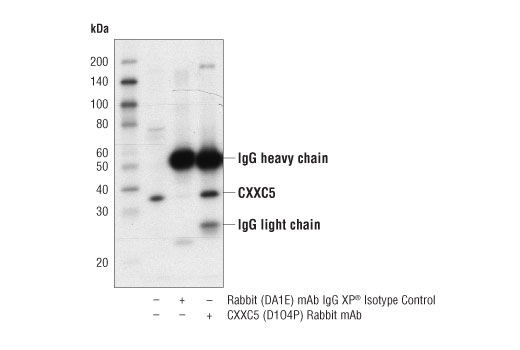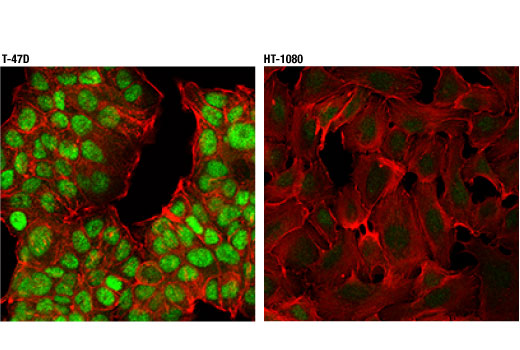WB, IP, IF-IC
H M R Mk
Endogenous
33
Rabbit IgG
#Q7LFL8
51523
Product Information
Product Usage Information
| Application | Dilution |
|---|---|
| Western Blotting | 1:1000 |
| Immunoprecipitation | 1:100 |
| Immunofluorescence (Immunocytochemistry) | 1:1000 |
Storage
Specificity / Sensitivity
Species Reactivity:
Human, Mouse, Rat, Monkey
Species predicted to react based on 100% sequence homology
The antigen sequence used to produce this antibody shares
100% sequence homology with the species listed here, but
reactivity has not been tested or confirmed to work by CST.
Use of this product with these species is not covered under
our
Product Performance Guarantee.
Bovine, Pig
Source / Purification
Monoclonal antibody is produced by immunizing animals with a synthetic peptide corresponding to residues surrounding Leu172 of human CXXC5 protein.
Background
The CXXC-type zinc finger protein 5 (CXXC5) is a nuclear protein that regulates gene expression and is involved in the regulation of cell growth and differentiation, apoptosis, cell adhesion, and cytoskeletal organization. The CXXC5 protein is also known as retinoid-inducible nuclear factor (RINF) as it was originally identified from a set of genes upregulated by retinoic acid stimulation (1). CXXC5 is a transcriptional activator of the vascular endothelial growth factor receptor VEGFR2. The CXXC5 protein regulates differentiation and migration of endothelial cells and subsequent blood vessel formation downstream of bone morphogenic protein (BMP) signaling (2). CXXC5 also regulates TNFα-induced apoptosis by facilitating phosphorylation of Smad3 and the nuclear translocation of Smad4 (3). Expression of CXXC5 in skeletal muscle regulates expression of genes involved in skeletal myogenesis (4). This nuclear factor also plays an important role in the regulation of normal myelopoiesis. The CXXC5 gene is localized to the 5q31.2 chromosomal region that is often involved in abnormalities associated with various myeloid malignancies, and CXXC5 over-expression is associated with decreased overall survival in human AML (5). Interestingly, CXXC5 is also over-expressed in many solid tumors, and high expression is also correlated with poor prognosis in breast cancer (6).
Species Reactivity
Species reactivity is determined by testing in at least one approved application (e.g., western blot).
Western Blot Buffer
IMPORTANT: For western blots, incubate membrane with diluted primary antibody in 5% w/v nonfat dry milk, 1X TBS, 0.1% Tween® 20 at 4°C with gentle shaking, overnight.
Applications Key
WB: Western Blotting IP: Immunoprecipitation IF-IC: Immunofluorescence (Immunocytochemistry)
Cross-Reactivity Key
H: human M: mouse R: rat Hm: hamster Mk: monkey Vir: virus Mi: mink C: chicken Dm: D. melanogaster X: Xenopus Z: zebrafish B: bovine Dg: dog Pg: pig Sc: S. cerevisiae Ce: C. elegans Hr: horse GP: Guinea Pig Rab: rabbit All: all species expected
Trademarks and Patents
Limited Uses
Except as otherwise expressly agreed in a writing signed by a legally authorized representative of CST, the following terms apply to Products provided by CST, its affiliates or its distributors. Any Customer's terms and conditions that are in addition to, or different from, those contained herein, unless separately accepted in writing by a legally authorized representative of CST, are rejected and are of no force or effect.
Products are labeled with For Research Use Only or a similar labeling statement and have not been approved, cleared, or licensed by the FDA or other regulatory foreign or domestic entity, for any purpose. Customer shall not use any Product for any diagnostic or therapeutic purpose, or otherwise in any manner that conflicts with its labeling statement. Products sold or licensed by CST are provided for Customer as the end-user and solely for research and development uses. Any use of Product for diagnostic, prophylactic or therapeutic purposes, or any purchase of Product for resale (alone or as a component) or other commercial purpose, requires a separate license from CST. Customer shall (a) not sell, license, loan, donate or otherwise transfer or make available any Product to any third party, whether alone or in combination with other materials, or use the Products to manufacture any commercial products, (b) not copy, modify, reverse engineer, decompile, disassemble or otherwise attempt to discover the underlying structure or technology of the Products, or use the Products for the purpose of developing any products or services that would compete with CST products or services, (c) not alter or remove from the Products any trademarks, trade names, logos, patent or copyright notices or markings, (d) use the Products solely in accordance with CST Product Terms of Sale and any applicable documentation, and (e) comply with any license, terms of service or similar agreement with respect to any third party products or services used by Customer in connection with the Products.


